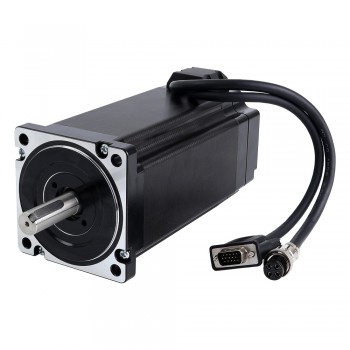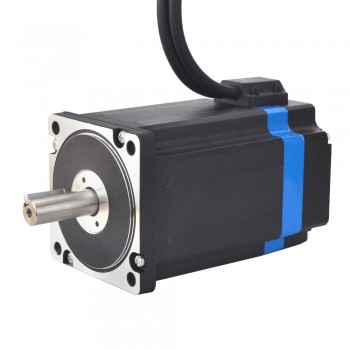Minnie's blog
1.Basic understanding of closed-loop stepper motors
A closed-loop stepper motor is a motor that achieves closed-loop control by adding an encoder structure. This motor not only has all the functional characteristics of a stepper motor, but also implements a feedback mechanism in motion control, thereby improving the accuracy and stability of motion. Closed-loop stepper motors achieve real-time monitoring and feedback control of motor position by adding an encoder structure to the motor. This feedback mechanism allows the system to make corrections based on the difference between the actual motion results and the target requirements, thereby improving the accuracy and stability of motion. Compared with open-loop controlled stepper motors, closed-loop stepper motors have significantly improved accuracy, stability, and response speed.

2.Working characteristics of closed-loop stepper motors
1.High-precision positioning: Through real-time feedback from the position sensor, the closed-loop stepper motor can accurately control the rotation of the motor, avoiding the problem of lost steps that may occur in traditional open-loop stepper motors and ensuring the accuracy of positioning.
2.Reduce vibration and noise: The closed-loop stepper motor can better control the torque and speed of the motor during operation, reducing vibration and noise, making the motor run more smoothly.
3.Improve operation stability: The introduction of the closed-loop control system makes the acceleration and deceleration response time of the stepper motor shorter, and the position response is almost synchronized with the input command, which is suitable for occasions that require rapid start and stop.
4.Enhance control flexibility: The closed-loop stepper motor can adjust the control parameters through software to adapt to different application requirements, without complex mechanical adjustments, and is more convenient to use.
3.Methods for increasing the speed of closed-loop stepper motors
1.Change the number of pole pairs: By changing the number of pole pairs of the motor, the speed of the motor can be changed while keeping the torque unchanged. This method is efficient and has a simple control circuit, but the speed regulation range is limited.
2.Variable frequency speed regulation: Variable frequency speed regulation can provide a wide range of speed regulation, and is suitable for low-load operation occasions, which can achieve the purpose of saving power and protecting the motor. However, this method is technically complex and costly.
3.Commutator motor speed regulation: It combines the simple structure of AC synchronous motor and the good speed regulation performance of DC motor, and is suitable for starting and speed regulation of high-speed and large-capacity synchronous motors. But the overload capacity is low.
4.Stator voltage regulation speed regulation: The circuit is simple, the device is small in size, and the price is cheap, but the slip loss is increased during the speed regulation process, the efficiency is low, and the speed regulation range is small.
5.Rotor series resistance speed regulation: The technical requirements are low and the equipment cost is low, but the additional slip power during the speed regulation process is all converted into heat energy loss, and the efficiency is low.
6.Electromagnetic slip clutch speed regulation: The structure is simple, the control device capacity is small, and the operation is reliable, but the speed loss is large and the efficiency is low.

4.Reasons for closed-loop stepper motor loss of steps
1.Load and torque imbalance: When the load is too heavy or the torque is insufficient, the stepper motor cannot provide enough torque to drive the load, resulting in loss of steps. In addition, if the control pulse frequency is too high or too low, it may also cause the stepper motor to lose steps.
2.Unstable power supply voltage: Fluctuation of power supply voltage will affect the running stability of stepper motor and cause lost steps.
3.Control signal interference: The driving mode of stepper motor is usually pulse control. If the control signal is interfered, it may cause stepper motor to lose steps.
4.Rotor acceleration is slower than rotating magnetic field: When the rotor acceleration of stepper motor is slower than rotating magnetic field, stepper motor may lose steps. This is because the input power of motor is insufficient and synchronous torque cannot make the rotor speed follow the rotation speed of stator magnetic field.
5.Inertia of stepper motor and its load: Due to the inertia of stepper motor itself and its load, the motor cannot start and stop immediately during operation, causing lost steps.
6.System resonance: If the frequency of control pulse is equal to the natural frequency of stepper motor, resonance will occur, causing stepper motor to lose steps.
7.Driver or controller interference: Signal interference of driver or controller may cause malfunction, thus causing stepper motor to lose steps.
8.The signal of the driver and the controller does not match: The signal bandwidth mismatch may cause the driver to miss pulses and cause the motor to lose steps.
